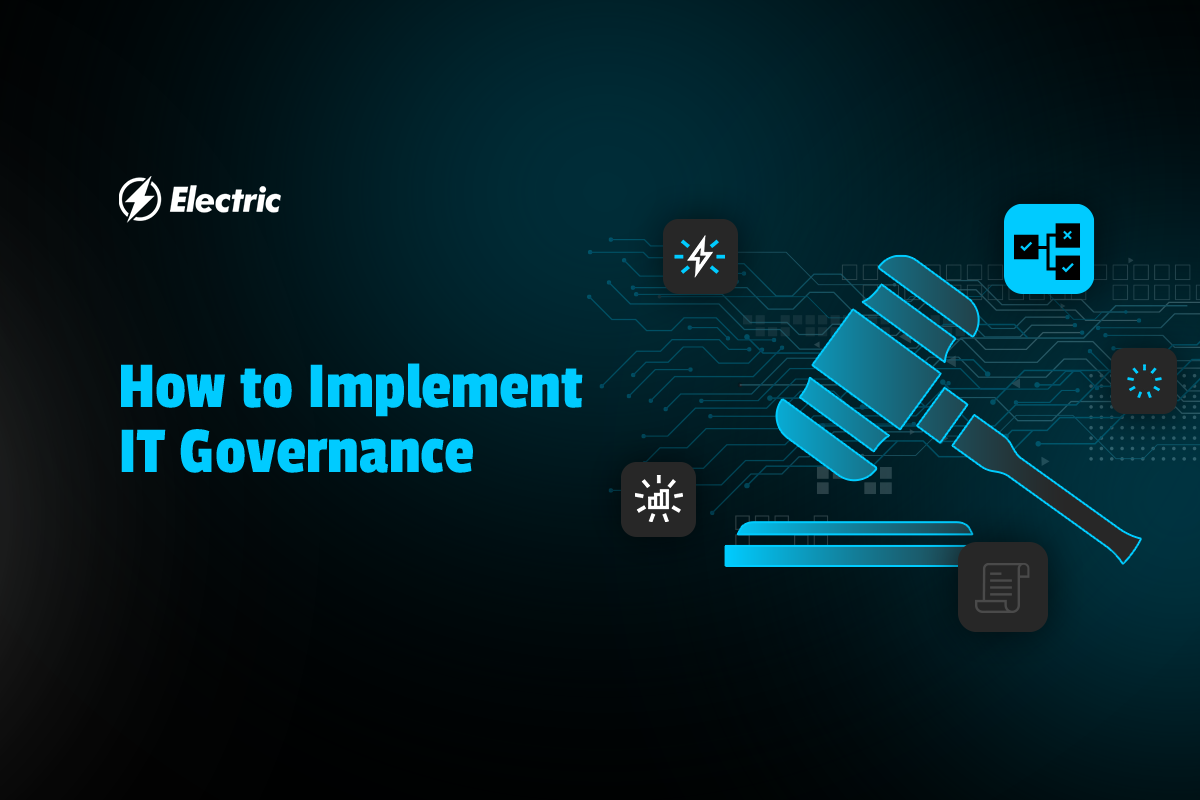
IT governance plays a fundamental role in small and medium sized businesses’ strategy alignment and risk management. Without IT governance, SMBs can experience improper identification of sensitive data, damage to critical services, and substandard security controls. Furthermore, misalignment between business strategy and IT weakens communication and prioritization, resulting in poor allocation of resources and a lack of transparency in risk management and reduction.
IT governance also forms an important subset of overall corporate governance. Yet, many SMBs underestimate the value of IT governance. This blog post will provide you with an overview of what IT governance is, why it matters in SMBs, what the most common frameworks are, and how to get started with implementation.
What is IT Governance?
IT governance is a formal framework comprising leadership, structure, and processes that provide organizations with a system that ensures their IT investments sustain and support their business objectives. IT governance aims to support decision-making in a structured and reputable way, which will enable the investment in, and use of, IT resources to achieve goals and objectives. Essentially, IT governance affects the degree to which an organization will get value from its IT investments.
Top-performing businesses of all sizes succeed in obtaining value from IT through proper implementation of IT governance. However, many SMBs mistakenly believe that this type of governance only falls under the remit of larger enterprises. Keep reading to learn more about the benefits of IT governance for small businessess.
Why is IT Governance Important for small businesses?
Small-to-medium sized businesses are often hailed as the world’s most booming and innovative engines for trade and growth. SMBs’ increasing role in driving economic progress, social integration, job creation, and innovation makes IT governance an essential consideration. Much like large, Fortune 500 companies, smaller businesses are heavily reliant on IT – and its effective governance – for the success of their business as they seek to exploit new opportunities to create value and competitive advantage.
While SMBs may be discouraged from pursuing a formal IT governance framework because of resource and budget limitations, the investment involved will reap financial benefits in the long term. IT governance is essential to ensure businesses are efficiently utilizing their existing IT infrastructure to support their objectives. Additionally, implementing a sound IT governance strategy is an effective way to help SMBs evaluate their ROI.
And finally, cybersecurity is a major concern for modern SMBs that can be addressed as part of IT governance. The framework you choose should encompass everything from standardizing IT processes, network security, data backup, and cloud services, to the management of the devices and software that make up the IT infrastructure in your organization.
Choosing an IT Governance Framework
An IT governance framework identifies processes and methods through which an organization can implement, manage, and monitor IT resources to meet business objectives. It provides a roadmap to address how decisions are made, who is responsible for making the decisions, and how they are communicated. The most commonly used IT governance frameworks include ITL, COBIT, and ISO 2000.
3 Types of IT Governance Framework
COBIT: Control Objectives for Information Technology
COBIT is a comprehensive IT governance framework of globally accepted principles, tools, and models focusing on the management of an organization through establishing the controls necessary for IT governance. The model is adopted to help in assessing the strength of the controls associated with the organization’s strategic goals. COBIT spans a larger part of IT governance through a more comprehensive evaluation method of the IT organization as a whole, determining its weaknesses and aligning improvement opportunities with those activities that best support the business strategy.
ITIL: Information Technology Infrastructure Library
ITIL comprises management best practices for strategy, design, operation, and continual service improvement. The framework provides an overall view of the service lifecycle to help in the identification of regulatory constraints and the design of the best possible services for the business. In a world where there are ever-changing rules and regulations, for instance, HIPPA or new laws from Homeland Security, there is a need for businesses to demonstrate compliance to these regulations. ITIL offers processes that help businesses comply with relevant data regulations and laws.
ISO 2000
ISO standards provide a model through which organizations evaluate their performance against defined requirements. The ISO standards provide guidance on the best practices for a given industry. ISO 2000 serves as a yardstick for measuring the success of IT systems in risk mitigation and performance management. Despite being a comparatively lengthy and expensive framework to implement, ISO 2000 provides a competitive edge for SMBs in the marketplace.
How to Implement IT Governance
Implementing IT governance requires collaboration between IT managers and stakeholders in the organization. The implementation process is an opportunity to bring IT managers to the C-suite in order to help make informed IT decisions. For successful implementation, it’s best to understand the needs of your organization and identify what is currently lacking. You should consider specific needs such as data protection, hardware, and compliance, among others, in order to select a suitable model.
The next step involves identifying your business goals, customer needs, and KPIs. This requires an in-depth understanding of the current systems and their weaknesses in meeting these objectives. Identify what investments you require to put your IT governance into action.
Lastly, identify compliance requirements. IT compliance involves the monitoring and evaluation of policies and procedures. IT executives and staff at all levels must proactively engage with business stakeholders in order to evaluate the success of the implemented policy.
Robust IT Governance Extends Business Value
Digital transformation and IT governance are essential elements of generating business value for SMBs. As the regulatory framework in IT advances every day, there is a need to remain compliant with existing laws whilst ensuring you generate value from existing IT infrastructure. To learn more about implementing IT governance in your organization, contact us today and schedule a demo.



